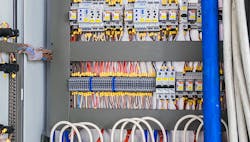A Control Design reader writes: What is the recommended minimum I/O spare terminal percent for junction boxes and main control panels?
Answers
Space planning
A general rule of thumb for spare I/O and terminal blocks for a control panel is 10% to 20%. This is just a recommendation. Many integrators or end users will realize they need an additional input or output device added to the system during installation or some time in the future. If there are no spare I/Os available, the user will need to add some type of remote I/O module to the system.
Janine Clunn / category manager / Allied Electronics & Automation / www.alliedelec.com
Less spare room
Each scenario brings specific requirements unique to that situation. This may best be answered by those who design and build control panels on a regular basis.
One general rule of thumb, if one exists, is 10/10/10 where 10% is for installed spare per I/O type in the panel, 10% for expansion of I/O and termination in existing I/O racks and 10% real-estate spare in a panel to allow for future remote racks with I/O modules and terminations. Of preferred spare space options, 10/10/10 is easy to remember.
Others recommend 20-25% spare space in panels, with 25% for expansion, although, over the past several years, real estate in control panels has become a major premium, so 25% seems too high in my view.
Answers to this question tend to be a moving target as design uncertainties arise from increasing the number of devices in control panels; people want to install more stuff in tighter spaces leaving far less spare room.
Another data point would be the engineering specification for Oracle Drive Systems, where it details this in specific terms: “Terminal rails shall carry 20% spare terminals. The spare terminals shall have blank markers fitted to allow the terminals to be labeled on-site, if required.”
While general practice may have been to plan for 20-25% expansion a decade ago, today’s builders have far less room to spare.
Alan Sappe’, product manager, industrial cabinet connectivity / Phoenix Contact USA / www.phoenixcontact.com
Rule of thumb
Controls engineers know that it is important to add in some spare I/O on the PLC or distributed I/O systems. As we all know, last-minute project changes can occur requiring additional I/O; or, during commissioning, a new device may have to be added to the system and needs to be controlled. So. the question is: How much spare I/O should be planned for? Engineers need to balance additional costs for spares versus the convenience of quickly addressing the need for additional I/O points. A good rule of thumb is to plan for 5% spares for large I/O count projects to 10% spare I/O for lower I/O count projects.
Charlie Norz / product manager for automation / Wago / www.wago.com
Plan for expansion
Just about all process plants are different in size, application, I/O type and strategy, therefore, with varying degrees of requirements for minimum spare I/O.
The risk of not having enough spare I/O laid out strategically in the plant could result in rewiring or purchasing not only new I/O, but potentially new cabinet and networking to accommodate the new additions to the plant. In general, plants should take a good look at what they expect of the next five years at their facilities.
Do they expect expansion with new units and plant areas and the need to be included in this capital expenditure?
Plan for it.
Also read: Which panel design standards are relevant?
If no large foreseeable unit expansion is planned, generally 20% is the recommended amount of spare I/O in a plant. This allows plants to have the flexibility to add I/O while the plant is running or at planned downtimes, without the need of reprogramming, purchasing and installing and all that added time and cost.
But when the question is about the minimum recommended amount of spare I/O, our experience tells us nothing under 10% of what you already are aware of.
Doug Ortiz / DCS product manager / Siemens / www.siemens.com
Application-specific
It's hard to define because it depends on the application and the project budget. However, it's always a good practice to set aside an extra 10% spare terminal for futureproofing or upgrades without going through a whole re-design, which may be an expensive exercise.
Ankur Tomar / global solutions development manager / Newark / www.newark.com
Faster signal wiring installation
Good control panel and junction box designs must consider the need for additional installation space and spare terminals for future use, over and above the minimum space needed to simply install and work with the components. While some areas of a machine are unlikely to be changed in the future, there are many areas where future expansion or upgrades will drive the need for more I/O terminals during the equipment service life. This is especially the case for I/O because the industrial internet of things (IIoT) initiatives are adding more field instrumentation for improved equipment monitoring. The question of how much spare space and installed capacity does not have an easy or standardized answer, but the need is generally greater for a main control panel as opposed to a field junction box. Extra space reserved in any panel makes it easier for technicians to work on the devices and provides more options for future expansion. Extra I/O terminal blocks installed in a panel makes it faster to add signal wiring in the future. However, panel size is obviously constrained by available room where the panel will be located and budgetary reasons. With all this being said, we often see end users and designers strive to allow about 20 to 25% spare installed terminal blocks and/or space, with 10% considered the minimum allowable.
Jerry Reaves / product manager for the wiring solutions group / AutomationDirect / www.automationdirect.com
About the Author
Anna Townshend
Managing Editor
Anna Townshend has been a writer and journalist for 20 years. Previously, she was the editor of Marina Dock Age and International Dredging Review, until she joined Endeavor Business Media in June 2020. She is the managing editor of Control Design and Plant Services.

Leaders relevant to this article:

